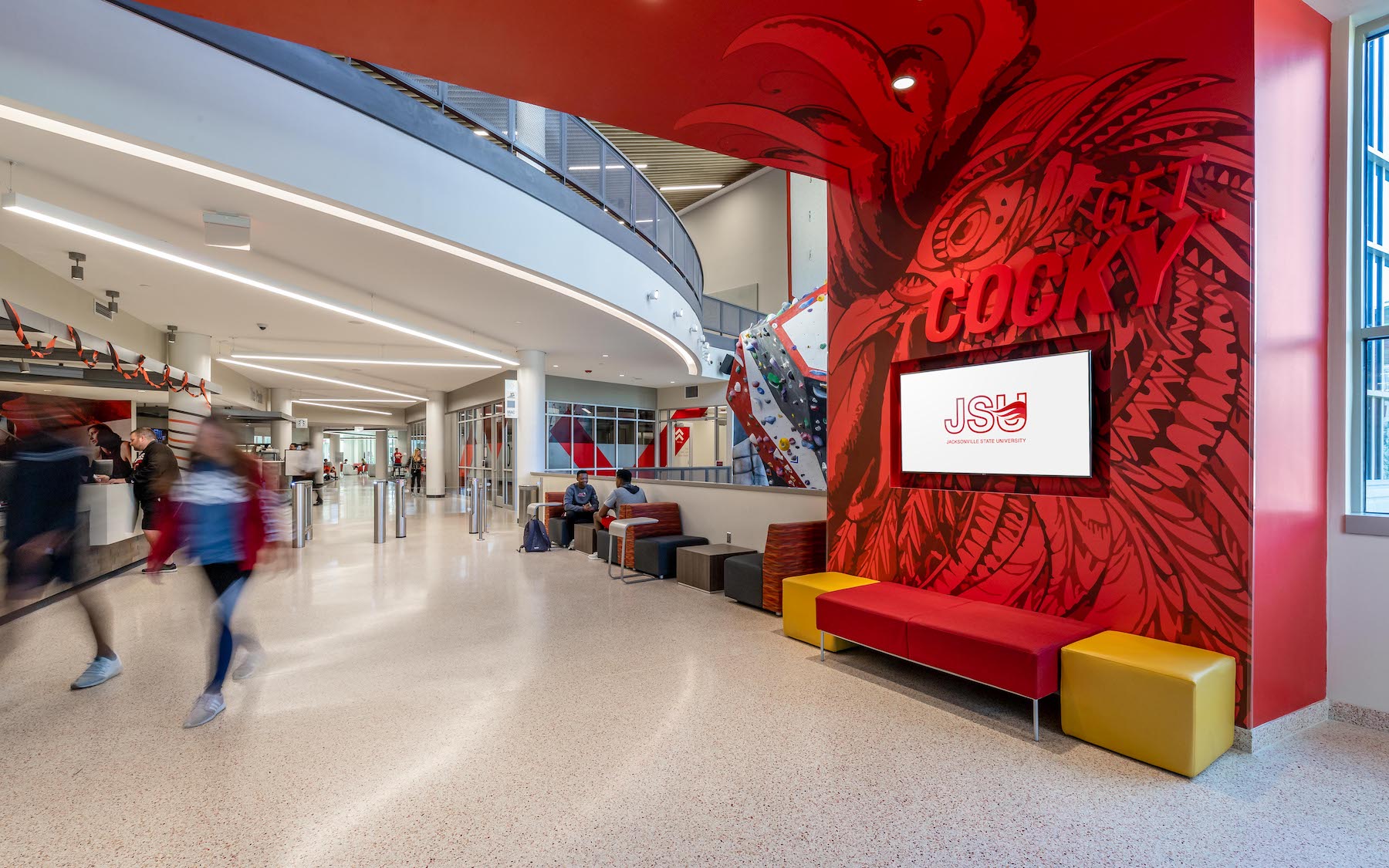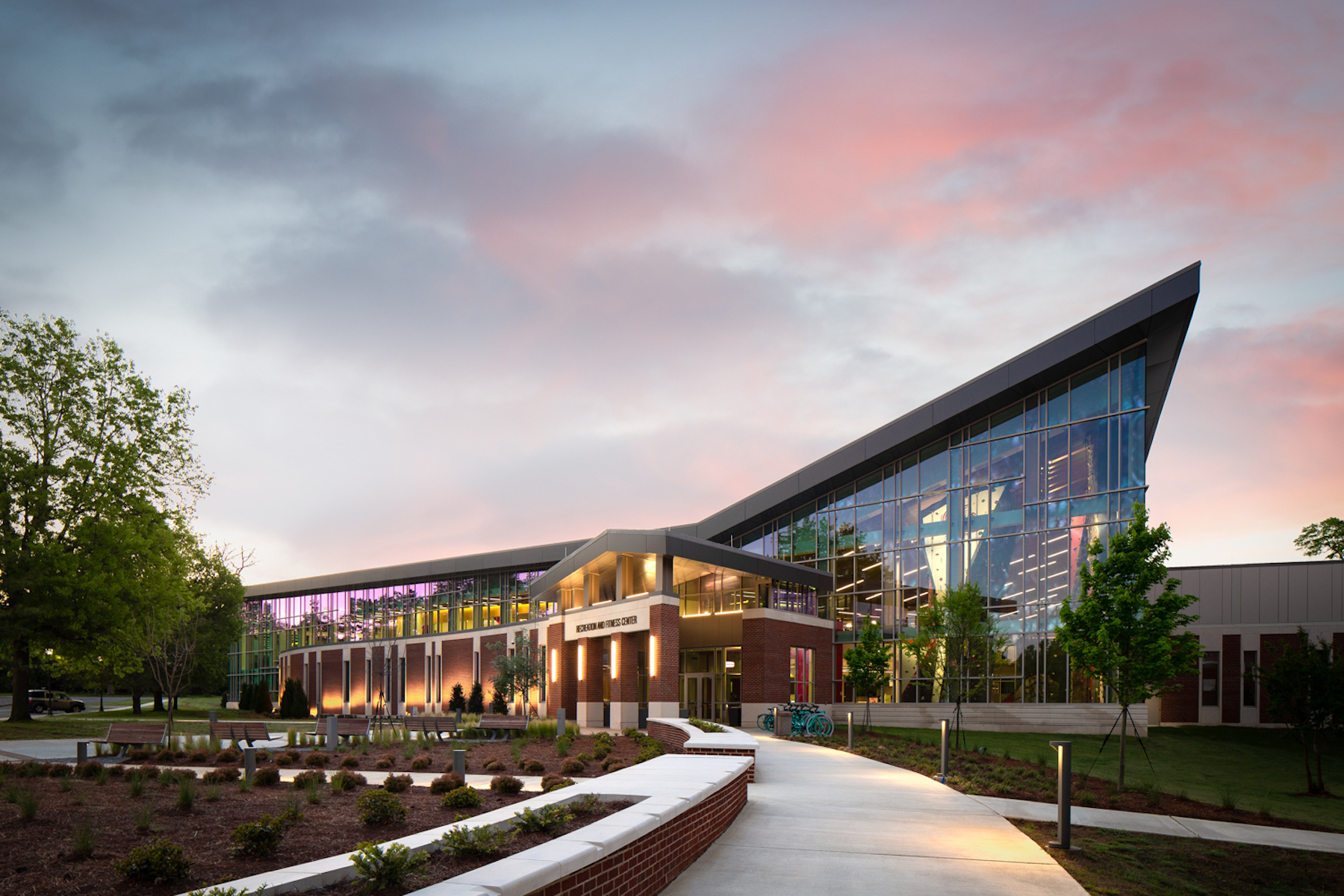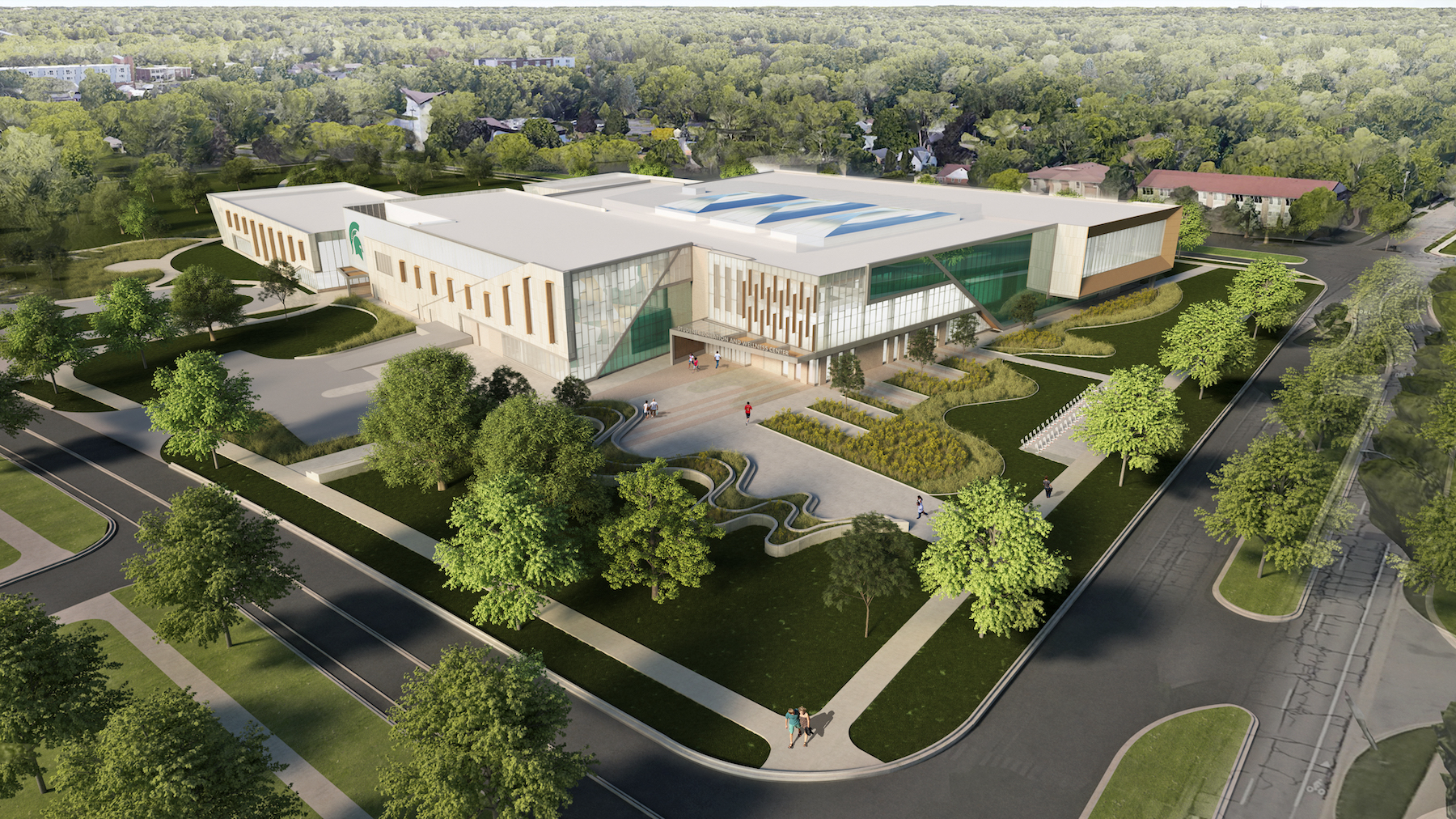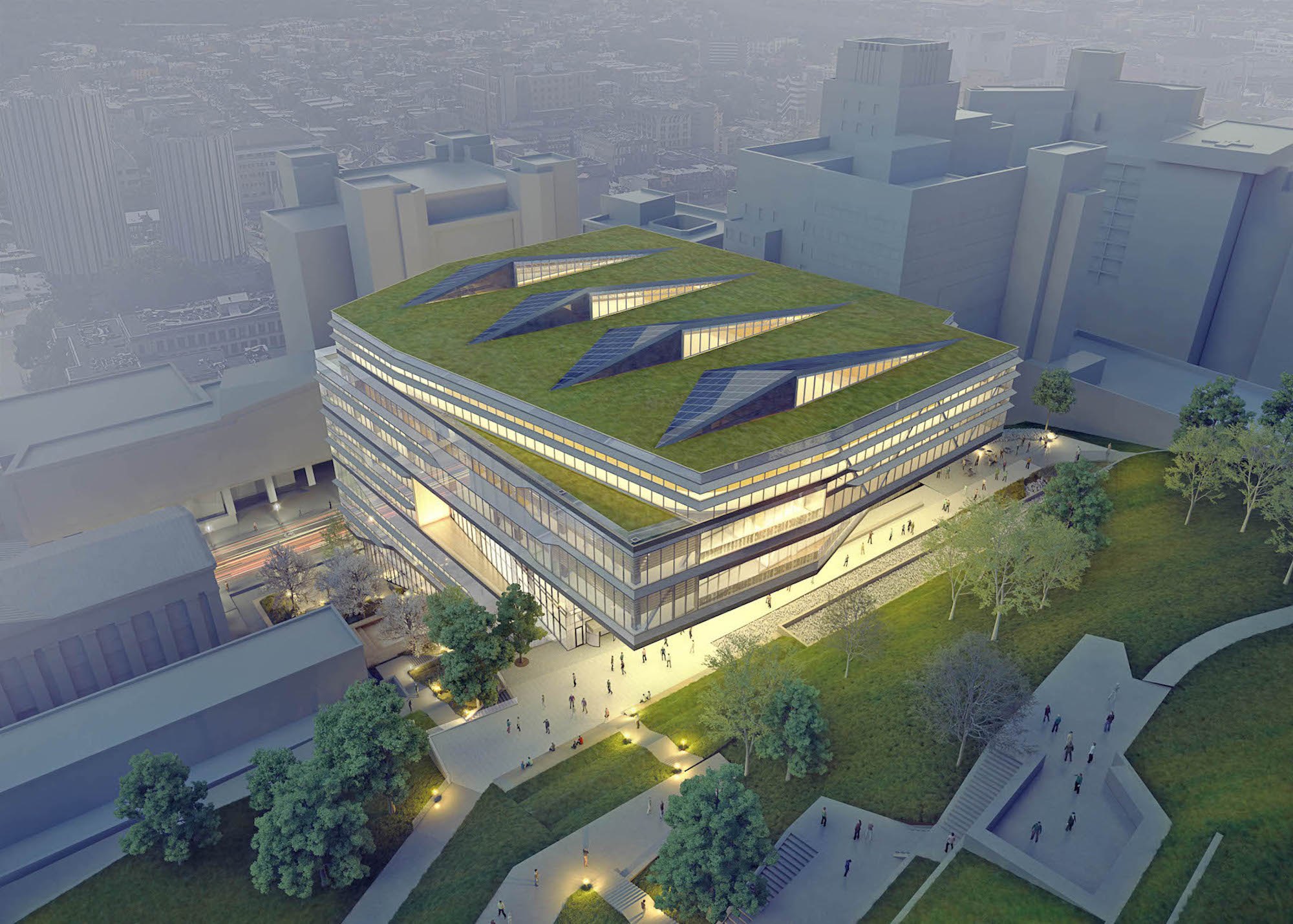On September 29 of last year, the University of Pittsburgh broke ground at its Oakland campus on a new Recreation and Wellness Center, a $255 million project whose 270,000 square feet will spread over nine stories, making this the tallest building of its kind in the U.S. when it opens in the fall of 2024.
Around the same time of the groundbreaking, Michigan State University in East Lansing was moving forward on its plans for a three-story 300,000-sf Health and Wellness Center that is scheduled to open in 2025, and whose design and programming were informed by focus groups with students.
The common thread connecting these projects is their design architect, Columbus, Ohio-based Moody Nolan, which celebrates its 40th anniversary last year. Over the past quarter-century, Moody Nolan has become one of the industry’s leading specialists in the creation of collegiate recreation facilities, according to Campus Rec magazine. The firm’s signature in this typology is designing rec centers to be campus destinations.
As such, Moody Nolan has had a ringside seat to watch how demand for rec centers has evolved to incorporate user well-being. “Our clients aren’t only concerned about physical space, but are also asking ‘why’ about these projects,” says Troy Sherrard, FAIA, a Partner and Sports + Recreation Practice Design Leader, who has been with the firm for 20 years. Consequently, he continues, more clients are requesting “hybrid environments” that “build habits” for health and wellness in students.
Shared spaces a priority for recreation centers


Sherrard says that certain “traditional” spaces, like athletic fields and courts, and even aquatic amenities, are still must haves in rec centers. On the other hand, Moody Nolan has seen less demand lately for racquet sports spaces, and more demand for “shared spaces,” such as turf gyms within fieldhouses, and climbing and bouldering options. Clients also want multipurpose rooms for activities that range from “high energy to mediation,” says Sherrard, who spoke with BD+C last week.
He points specifically to the 101,000-sf, $30 million rec center at Jacksonville State University in Alabama, which opened in January 2019. Sherrard says prior to that opening, fitness and wellness were not prevalent concerns for most rural southern schools. Jacksonville State, conversely, saw the new rec center—which would have the largest footprint of any building on its campus—as one of its “anchors.”
The building’s highlights, says Sherrard, feature a 43-ft-tall outdoor climbing wall, social engagement spaces that include a campus “living room,” and an outdoor “adventure” component for biking and walking. Sherrard adds that rec centers need to be immersive, which in Jacksonville State’s case meant telling a design story through branding “to root the student in a sense of place.” (He notes that anyone walking into this rec center can see most of its rooms at first glance.)
How recreation centers can reinforce student health
After Jacksonville State opened its rec center, its enrollment for the next fall semester jumped by 6 percent. (The school’s full- and parttime enrollment for the fall of 2022 was 9,633, compared to 7,696 in the spring of 2018.)
Other campuses around the country flaunt their recreational and athletic facilities as recruitment bait. “That always comes up, and without [a rec center] there’s a void,” says Sherrard. He points out that Penn State University’s rec center (designed by his firm) is across the street from the college’s Admissions building, so the rec center is the first thing prospective and incoming students and their parents see, accentuating the college’s commitment to health and wellness.

Appealing to student needs is at the forefront of rec center design and operations, says Sherrard. Moody Nolan’s focus groups for the Michigan State University project (for which Rossetti is the AOR) revealed two desired trends that became key design drivers: biophilia and what Sherrard calls “zones for discovery.”
This rec center’s design is created around a courtyard. According to MSU, the building’s front façade opens to an outdoor greenspace with “large spans of glass for natural daylight and ventilation, allowing for integrated indoor-outdoor functional fitness experiences.”
Each floor of Pitt’s Recreation and Wellness center will have a different emphasis: dining, free weights, swimming and aquatic exercise, a gym, a jogging track, a multipurpose room, etc. The building itself, built into an 85-ft hillside, will connect Pitt’s upper and lower campuses. Also built into the hillside will be a 160-step “Panther Run,” that includes an outdoor platform halfway up for fitness classes.
Given its verticality, Pitt’s Recreation and Wellness center “could be a game changer” for urban-situated rec centers, says Sherrard.
Related Stories
University Buildings | Jun 26, 2023
Addition by subtraction: The value of open space on higher education campuses
Creating a meaningful academic and student life experience on university and college campuses does not always mean adding a new building. A new or resurrected campus quad, recreational fields, gardens, and other greenspaces can tie a campus together, writes Sean Rosebrugh, AIA, LEED AP, HMC Architects' Higher Education Practice Leader.
Standards | Jun 26, 2023
New Wi-Fi standard boosts indoor navigation, tracking accuracy in buildings
The recently released Wi-Fi standard, IEEE 802.11az enables more refined and accurate indoor location capabilities. As technology manufacturers incorporate the new standard in various devices, it will enable buildings, including malls, arenas, and stadiums, to provide new wayfinding and tracking features.
Engineers | Jun 14, 2023
The high cost of low maintenance
Walter P Moore’s Javier Balma, PhD, PE, SE, and Webb Wright, PE, identify the primary causes of engineering failures, define proactive versus reactive maintenance, recognize the reasons for deferred maintenance, and identify the financial and safety risks related to deferred maintenance.
University Buildings | Jun 14, 2023
Calif. State University’s new ‘library-plus’ building bridges upper and lower campuses
A three-story “library-plus” building at California State University, East Bay (CSUEB) that ties together the upper and lower campuses was recently completed. The 100,977-sf facility, known as the Collaborative Opportunities for Research & Engagement (“CORE”) Building, is one of the busiest libraries in the CSU system. The previous library served 1.2 million visitors annually.
Higher Education | Jun 14, 2023
Designing higher education facilities without knowing the end users
A team of architects with Page offers five important factors to consider when designing spaces for multiple—and potentially changing—stakeholders.
University Buildings | Jun 9, 2023
Cornell’s new information science building will foster dynamic exchange of ideas and quiet, focused research
Construction recently began on Cornell University’s new 135,000-sf building for the Cornell Ann S. Bowers College of Computing and Information Science (Cornell Bowers CIS). The structure will bring together the departments of Computer Science, Information Science, and Statistics and Data Science for the first time in one complex.
Student Housing | Jun 5, 2023
The power of student engagement: How on-campus student housing can increase enrollment
Studies have confirmed that students are more likely to graduate when they live on campus, particularly when the on-campus experience encourages student learning and engagement, writes Design Collaborative's Nathan Woods, AIA.
K-12 Schools | May 30, 2023
K-12 school sector trends for 2023
Budgeting and political pressures aside, the K-12 school building sector continues to evolve. Security remains a primary objective, as does offering students more varied career options.
K-12 Schools | May 22, 2023
The revival of single-building K-12 schools
Schools that combine grades PK through 12 are suddenly not so uncommon. Education sector experts explain why.
K-12 Schools | May 17, 2023
Designing K-12 schools for students and safety
While bullying, mental health, and other acts of violence are all too common in schools today, designers have shown that smart and subtle preventive steps can make a big difference. Clark Nexsen’s Becky Brady shares how prevention and taking action at the design level can create safe and engaging learning environments.

















